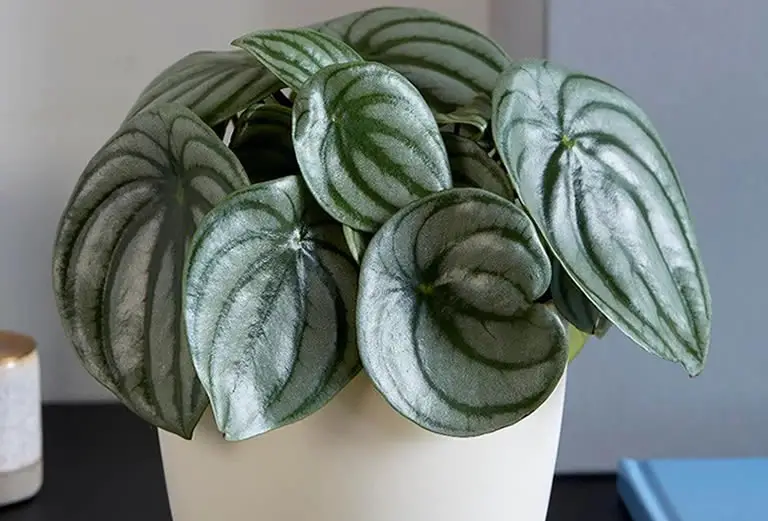The peperomia, or radiator plant, is a popular perennial epiphyte (a plant the requires another plant to grow). It is cultivated in indoor and outdoor gardens alike. But with more than 1,000 species in the genera, many peperomia plant owners wonder how they should care for their particular peperomia.
In this guide I will cover all the care needs of the peperomia plant in a way that will allow you to tend to your individual plant regardless of which species of peperomia you have. I cover both indoor and outdoor plants.
I have written this guide to be very beginner-friendly but with enough expert advice to offer the seasoned indoor gardener some helpful insight into cultivating a healthy vibrant peperomia plant.
Table of Contents
- Peperomia Plant Care Guide
- The Perfect Type of Soil For a Peperomia Plant
- Peperomia Light Requirements
- Peperomia Plant Watering Guide
- Peperomia Plant Humidity Guide
- The Ideal Temperature For A Peperomia Plant
- Peperomia Plant Fertilizer Guide
- The Problem With Peperomia Blooms
- How To Make Your Peperomia Grow Bigger & Fuller
- Peperomia Plant Pruning Guide
Peperomia Plant Care Guide
Below is a bullet list that you can use as a quick guide after you have read the entirety of this article.
Here’s how to care for a peperomia plant:
- Use well-draining soil.
- Give the plant at least 12 hours of medium or bright, indirect light per day.
- Water when the top layer of soil dries out.
- Keep humidity levels between 40% and 50%.
- Set temps between 60° and 80° Fahrenheit.
- Apply a balanced fertilizer a few times per year during growing season.
The following guidelines to peperomia plant care cover everything you need to know about cultivating, growing and caring for this fascinating plant.
Below I touch on the above care facets and also talk about pruning the peperomia for increased growth and to encourage blooming (if that’s something you want).
Peperomia basics
First, let’s delve a little bit into what type of plant you should be expecting if you bring home a peperomia.
As I mentioned in the intro, the common name for this plant is the radiator plant.
Technically, peperomia is a genus rather than a species, as there are at least 1,000 species of peperomia plants out there.
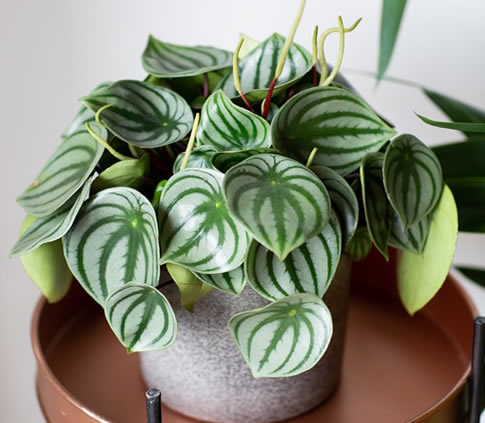
All peperomia plants grow throughout the subtropical and tropical regions of South and Central America, though a limited number of species grow natively in Africa also.
Peperomias are epiphytic, which means the plant will choose another plant as a surface on which to grow.
Epiphytic plants, like peperomia, will often nestle into the nooks of trees where they send their roots down into areas of slightly decaying bark.
This means peperomia have evolved with roots that require more oxygen that many other plants. Thus peperomia need a lot of airflow around the rootball – something that you must mimic in the soil of a peperomia houseplant, as I will cover later.
Peperomia also grow in a shady spots where the plant is protected from strong direct sunlight, such as under the cover of a much larger tree, but where they still get strong indirect light
Peperomias are highly decorative, especially when you get into certain species like the Peperomia prostrata (commonly called string of turtles) with its turtle marked foliage.
Likewise the Peperomia griseoargentea (often called Ivy Leaf and Peperomia Ivy) with its gorgeous silvery leaves looks amazing.
The classic species, the Peperomia argyreia (which is also known as the watermelon peperomia) is so named because it features darker green stripes across lighter green leaves. It looks great in any indoor space.
In most cases peperomia are grown as houseplants, especially in the US, though it can be grown outdoors in USDA climate zones 10 through 12.
Contrary to popular opinion peperomia is not a succulent
A question that I hear often, and for good reason, centers upon whether or not a peperomia plant is a succulent.
Peperomia is not a succulent.
Peperomia plants are considered to be succulent-like though, due to their drought-resistant nature and because their care needs are similar to those of many succulents.
Since peperomias grow on surfaces rather than in the ground, and due to their natural drought-resistance, they’re considered succulent-like. They are not succulents in the strictest sense however.
Although peperomia usually has fleshy, thick leaves and can go a long time without being watered, just like a succulent can it does have slightly different care needs to the average succulent. So, it is important not to confuse the two types of plants.
For example, plants that are succulent-like will often require a very different soil type from succulents and potting them in succulent soil will damage the plant and may even kill it.
You can grow peperomia indoors or outdoors
Where should you expect to see a peperomia plant – inside the home or in the yard?
Peperomia are both indoor and outdoor plants. They can be grown outdoors in USDA climate zones 10 – 12 and can be grown as an indoor plant in any area as long as they receive the correct care.
Let’s take a look at both indoor and outdoor peperomia now.
Be careful growing peperomia outside if you don’t live in a tropical climate zone
You might not necessarily have a lot of room in your home or office for an indoor garden.
Maybe you’d like to start growing plants outside and want to add peperomia to that list.
Can you grow this genus of plant outdoors?
Peperomia can live outside only in USDA hardiness zones 10 through 12. As a tropical plant peperomia needs a warm climate to grow outdoors.
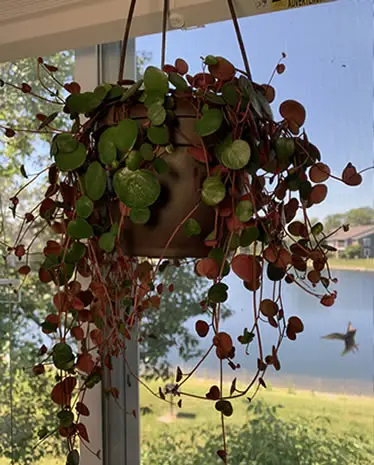
Here is a map from the United States Department of Agriculture or USDA that showcases the entirety of the US in hardiness zones from 1a through 13b.
We also have a handy guide with information on gardening for your climate zone here.
Hardiness zones between 10 and 12 are very hot regions in the southernmost point of the US – for example Southern California.
As you’ll recall from the last section, peperomia species grow in tropical and subtropical regions, so the warmer parts of the US make perfect environments for growing peperomia outdoors.
It’s not like you can create artificial or natural sources of heat for an outdoor plant like you can with one grown indoors, so if you’re not in the right hardiness zone for a peperomia to survive, then you might want to rethink growing this plant outdoors.
Peperomia makes a good indoor plant in any climate zone
Although peperomia can only be grown outdoors in warmer, drier climates does this mean there are restrictions on where it be be grown as an indoor houseplant?
Peperomia makes a good indoor plant. The average home maintains a perfect temperature for peperomia and usually has adequate humidity levels.
However, as peperomia requires a lot of indirect light it may be necessary to give the plant some artificial light during the winter months.
As I cover in the sections below peperomia requires a lot of light.
To maintain the health of your plant and encourage growth you must ensure the plant gets at least 12 hours of good indirect light per day. This may mean using a grow light, especially in the winter months when daylight hours are shorter (more on this later).
The average home usually provides ideal temperatures for peperomia year-round thanks to modern climate control.
Humidity levels in the average home usually also fall into an adequate range for peperomia.
However, if the humidity levels in your home are below 30% then you may also need to use a cheap plant humidifier to boost those levels directly around the peperomia plant.
If they are above 40% you will want to take the actions outlined in a later section to reduce humidity around your plant.
Peperomia is an easy-care plant
You might not have a lot of time to dedicate to growing plants whether they be indoors or outdoors and so need a plant that doesn’t require a lot of attention.
Easy-care houseplants are almost essential in the modern world for anyone who wants some greenery in their home as the days when someone stayed at home all day and tended to the house are long gone.
So, are peperomia easy-care plants?
Peperomia are considered easy-care plants. Most homes provide good conditions for growing peperomia houseplants.
Though they are not succulents but are only succulent-like, they peperomia plants do require the same amount of attention as easy-care succulents. They therefore require sparse watering and very limited fertilization.
You can enjoy a very hands-off care schedule when it comes to peperomia.
Only in the winter might you need to provide the plant with a little extra humidity and some artificial light. The rest of the time the plant requires very little attention.
The Perfect Type of Soil For a Peperomia Plant
Without further ado, I want to jump into the care facets of growing peperomia species, whether you intend to cultivate the plant indoors or outdoors.
Below I cover all the basic needs of peperomia as well as the ideal care schedule you must follow.
Let’s start by talking about the type of soil that the plants in this genus require.
What kind of soil does peperomia need?
Getting the soil type wrong for peperomia can be disastrous for your plant.
I am shocked by how many people I come across that have potted their peperomias in regular potting soil. They are then bewildered as to why their plant is suffering.
A smaller number of peperomia owners will pot their plant in succulent, and this is just as bad.
Peperomia requires a special type of soil. Peperomia soil must be well-draining and aerated!
Potting mix will not drain away water fast enough to protect peperomia roots from damage, while succulent soil, although fast draining, will not provide enough airflow to the roots and they will choke from lack of oxygen.
I can’t stress enough how much fast-drainage and good-airflow soil qualities matter when growing a peperomia.
If the soil is too compacted, then standing water can accumulate (potting mix will do this).
The peperomia is already prone to root rot, which we’ll talk about later and so, standing water is a huge potential problem when growing this plant.
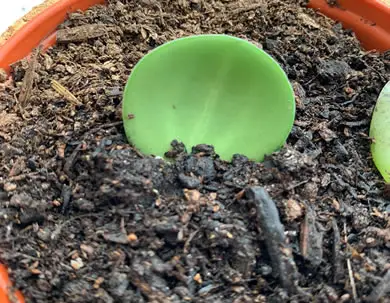
Peperomia species are epiphytic, as you’ll remember, and so the plant’s roots need more oxygen than your average plant. That’s why aeration is critical.
How do you ensure the soil is adequate for the peperomia?
You can take a basic soil mix and then add soil amendments.
The 3 components of the ideal peperomia soil mix
I prefer to make up my own soil mix for epiphytic plants as I have found that store-bought soil mixes are not mixed exactly right for these unique plants.
Soil mix for peperomia:
- 1 part compost or potting mix (for nutrients).
- 1 part vermiculite or perlite (for water-drainage).
- 1 part pumice or oak bark, or similar (to promote good airflow).
The compost in the soil mixture provides peperomia with all the nutrients it needs while the perlite allows for fast water-drainage.
The addition of pumice ensure the soil maintains good airflow.
Alternative compounds you can use in your soil mix
Below are some other compounds that you can use if you have them to hand.
Remember that the mix you should use is: 1 part drainage compound + 1 part nutrient compound + 1 part airflow compound.
Drainage compound – gravel
A type of inorganic soil amendment, large chunks of gravel in the soil will prevent your peperomia’s soil from becoming too compact.
That said, the gravel pieces shouldn’t be so large that they can redirect water flow.
Drainage compound – sand
The grit of sand when added to soil has plenty of advantages. Sand can keep the soil nice and loose, enhance drainage, and improve aeration by introducing air pockets.
However, too much of a good thing can become a bad thing, so use sand sparingly. Overdoing it can dry out the soil too much.
You’ll end up overcompensating and watering too often, which could again put your peperomia plant at risk of root rot.
Although sand is often used in soil mixes for epiphytic houseplants I tend to stay away from it.
As a soil addition for succulents it works great but for epiphytes it can eventually restrict airflow movement and choke off oxygen to the roots. To be safe go for a different drainage compound.
Drainage compound – perlite/vermiculite
Perlite is a type of volcanic glass that occurs when obsidian undergoes hydration.
Vermiculite is a naturally occurring mineral made up of magnesium-aluminum-iron silicate.
As a soil aerator, perlite and vermiculite will prevent the soil from compacting or becoming too dense. Either of these substances will also ensure soil drainage will increase as well.
Nutrients compound – peat moss
If you are not going to use compost or regular potting soil in your peperomia soil mix then I’d suggest peat moss as an alternative.
Coming from Ireland I’m very familiar with the many benefits of using peat with garden plants. Peat moss is a type of decaying, dead sphagnum moss that develops deep in bogs and it is rich in nutrients.
Peat moss is superior for water retention though as the dead moss is capable of storing 20 times its own weight in water.
The moss then gradually releases that water so the soil doesn’t get overly dry. So be aware that too much of it in your soil mix will cause problems for a peperomia.
Remember to only use 1/3 peat moss along with a good drainage compound and airflow compound.
On the positive side, as well as providing a high nutritional content to your soil mix, peat moss will also aid in aeration as it prevents soil compaction.
This soil amendment can also hold onto nutrients that are added when you fertilize the peperomia and release them slowly, like it does water, as it raises the peperomia’s cation exchange capacity.
Peat moss can expire, though it usually takes years for it to happen. This means repotting every 3 years or so is essential for a houseplant potted in peat.
Airflow compound – coco coir
The last soil amendment we’d recommend for the peperomia, as an alternative to pumice or oak bark, is coconut coir or coco coir.
This amendment is sourced from the exterior husks of coconuts and is usually sold in bricks or blocks.
Adding coconut coir to your plant’s soil is a great way to keep it loose so that standing water can’t accumulate and air can flow freely.
Heavier, clay-based soil becomes lighter with this coconut byproduct,. Be aware though that coco coir has some water-retaining properties as well so it should not be your first choice.
Peperomia Light Requirements
Peperomia needs at least 12 hours of strong indirect light per day though it will grow quite happily in up to 16 hours of indirect light per day.
All plants need sunlight to allow for photosynthesis as without it they cannot grow. It doesn’t matter so much whether that light comes from the sun or an artificial grow light. What’s most important, as far as peperomia is concerned, is that the light it gets is indirect light.
Some peperomia species are fine in medium light. This means that the light is diffused by something such as curtains before reaching your plant.
Other peperomias prefer very bright, strong indirect light. Indirect light requires that sunlight bounces off something before it reaches your plant i.e. the location you place the peperomia in should be well lit with natural light but direct sunlight.
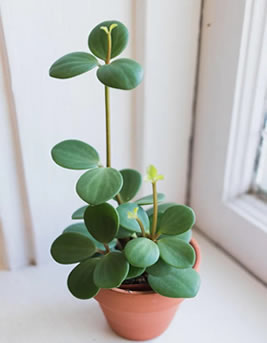
In the image above you can see a peperomia growing beside a window.
However this window is not sun-facing and only receives indirect light.
Peperomia does not need direct sunlight
I often get asked if peperomia needs sunlight. I have found over the years that the term “sunlight” means different things to different people. To some it means direct sun while to others it simply means natural light (i.e. does the plant need to be kept away from shade).
Peperomia does not need direct sunlight. In fact it should not be given full sun. However, it requires at least 12 hours of strong indirect light per day.
If less light is available the shortfall in hours of light will need to be provided by artificial light via a grow light.
Peperomia will grow best with 12 – 16 hours of strong indirect light. If your plant is getting less than 12 hours of good indirect light per day then you will need to give it artificial light to make up the difference via a grow light.
Note: you should never expose any peperomia species to direct sunlight.
Even if your peperomia has very large leaves, the poor plant could develop leaf burn it if sits too long in bright sunlight.
The leaf burn will at first manifest as bright white spots across your peperomia’s foliage. The spots will resemble bleach marks.
Give it a few days and those spots will become brown and crispy. This is a result of the death of the tissue due to UV ray exposure.
Outside of that foliar damage, you may also notice brown leaf tips and margins, yellowing leaves, and wilting of the foliage when peperomia is exposed to direct sunlight.
If your peperomia species got too much sunlight and starts to display leaf burn you need to move it to a shadier spot but not to a location that is in full shade.
Peperomia may react poorly to full sun but the plant will develop other serious problems if it doesn’t get enough good indirect light.
In instances of leaf burn, replenish the plant with water after you have moved it to a more suitable location and it will probably recover.
The plant is a slow grower though so it can take time to regain its lush look.
Speaking of shady spots, they’re generally not the friend of the peperomia any more than a spot that gets direct light is.
Peperomia requires good indirect light to thrive
The peperomia plant may be intolerant of direct light, but it won’t grow without enough indirect light either.
A minimum of 12 hours of indirect light per day is needed to maintain growth. If you need to use a grow light to make up for any shortfall in the hours of light the plant receives, especially in winter, then you should do so.
If you have a variegated peperomia species, such as the watermelon peperomia or the Peperomia griseoargentea, a lack of strong indirect light can cause the appealing coloring and patterning of the leaves to disappear permanently.
Peperomia Plant Watering Guide
You’ll recall that peperomia species are succulent-like. Succulents require the least amount of watering among all houseplant types and peperomia are no different.
How often you should water a peperomia plant
Being succulent-like a peperomia plant does not require watering as often as most of your other houseplants will, but exactly how often should you water it?
On average a peperomia plant needs watered once every 2 weeks. However, it is best to water peperomia only once the top 1 ½ inches of soil has dried out rather than sticking to a set schedule.
You want to allow 1 ½ – 2 inches of the soil to get dry before you give your peperomia fresh water. How long will that take? That’s hard to question to answer as the time between waterings will greatly depend on conditions in your home. However, as a rule of thumb every 2 weeks is about right.
Having said that, when it comes to watering peperomia houseplants it could be as little as one week or as much as three weeks between waterings. It all depends on what the weather is like in your region and the temperatures in the area where the plant is located.
If you live in colder temperatures, then you can usually go quite a long time between watering your peperomia. In hotter regions, the water in the pot evaporates faster, so you’ll have to replenish your houseplant faster. The same applies if you home is cooler than the average home or hotter than the average home.
Either way, I would only caution you to water the peperomia when the top of its soil is dry. It is best to use a moisture monitor (they only cost a few dollars) making sure you push the spike down to a depth of 1 ½ – 2 inches. When the monitor reads “dry” you can water your plant.
A caution about overwatering peperomia: just as is the case with succulents, if you water a peperomia too often, such as every day or every couple of days, then you can induce a very serious condition known as root rot.
Root rot is a fungal disease caused by standing water. In some cases, compacted, hardened soil can lead to root rot but 9 times out of 10 it is due to an aggressive watering schedule.
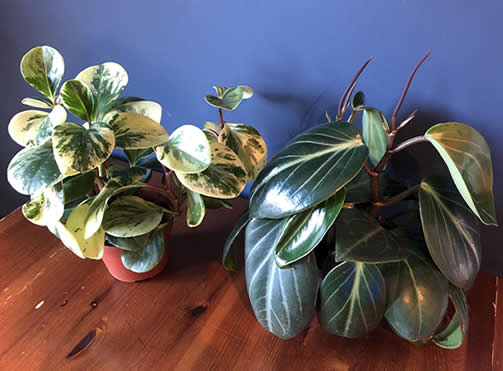
A peperomia plant’s roots survive on oxygen and water just like people do. When you add too much water and take away oxygen, your peperomia begins to drown.
When overwatered peperomia plant roots will wither and die, often giving off quite a distinguishable odor that smells bad (see the article why does my aloe smell bad).
As the roots rot they become unable to absorb both moisture and nutrients from the soil for distribution to the rest of the plant. The plant begins to starve, but even worse it begins to dehydrate from lack of water, even though the plant roots are sitting in a pool of it.
You’ll then notice symptoms like thinner branches, pale and small leaves, foliar discoloration (yellowing or browning), and plant death will quickly follow if immediate action is not taken.
Root rot kills plants of all kinds, as it’s hard to save the plant if the case of root rot is quite advanced. You’ll know your plant won’t make it once you see more brown or black roots than white ones.
So, it is imperative you get your watering routine correct from the outset. This is why I always recommend using a moisture monitor at least until you get used to your particular plant’s watering needs and can create a schedule based on that.
How to water peperomia correctly
Now that you know when to water your peperomia it’s time to look at how to water it.
- You should water peperomia from the bottom.
- Fill a container, or sink, with a few inches of water.
- Place the plant in the water making sure the water doesn’t reach the lip of the pot.
- There is no need to remove the plant from its pot.
- Allow the soil to soak up the water for about 20 minutes.
- Then remove the plant and allow the excess water to drain off before returning the peperomia to its permanent location.
Watering peperomia from the bottom is always the preferred method of hydrating the plant.
Although you can water peperomia from the top, as the leaves do not mind getting wet (unlike almost all succulents), watering from the bottom is a better way to ensure the plant gets the exact amount of moisture it needs without running the risk of saturating the soil.
Also, oftentimes peperomia foliage makes seeing the soil difficult so you never know just how much water to add when watering from the top.
Additionally, when watering from the top a lot of water can run off the foliage and never make it to the soil.
Peperomia Plant Humidity Guide
All around us is humidity, even though you might not necessarily feel it.
Your home, your office, the grocery store, the gym, it all has humidity.
So what type of humidity does peperomia need?
Peperomia is a tropical plant that likes more humidity than you do
Given peperomia’s native tropical home, it should come as no surprise that this plant needs humidity. What may be surprising to you though (it was to me when I first learned it) is just how little humidity this tropical plant needs.
Peperomia plants like humidity levels between 40% – 50%. The average home maintains humidity levels between 40% – 60%.
So, in most cases no additional actions are needed to increase humidity around a peperomia.
The average rate of humidity for indoor environments is between 30 and 50 percent. Thus, making peperomia great for indoor use.
As peperomia only need between 40 and 50 percent humidity you might not have to do anything at all to achieve the proper humidity requirements for this dashing plant.
Your home is likely already humid enough just the way it is.
If you worry that your peperomia plant isn’t getting enough humidity, don’t worry. It will tell you. You’ll notice that the stems and leaves of the plant will begin wilting.
The leaves can also take on an appearance like they’re frying in the sunlight, becoming crispy, brown, and shriveled up.
You might even see a leaf scorch type of effect where the leaf margins and veins become yellow. These leaf scorch symptoms are likeliest to affect a plant’s older leaves.
If the humidity levels in your home are below 30% then you may need to use a cheap plant humidifier to boost those levels directly around the peperomia plant.
Alternatively, should your peperomia not be receiving enough humidity, try moving it to your bathroom if you’re growing the plant indoors in your home.
The bathroom is more than moist enough for this plant.
In most cases though, where humidity levels are not ideal for peperomia, it is due to high humidity rather than low humidity as most homes rarely fall below 30% humidity.
A simple solution for reducing humidity is to place a few humidity-lowering plants close to your peperomia. If the humidity levels are particularly high or you want a solution that doesn’t require extra plant care consider getting a cheap
dehumidifier .
Also consider using a cheap temperature and humidity monitor to ensure your plant is growing in the ideal conditions.
You can mist peperomia
Misting is often used to help increase humidity around plants. So should you mist your peperomia?
Peperomia likes to be misted every other day but only when misting does not increase humidity levels around the plant to over 40%. Peperomia grows naturally in areas with relative humidity and thus has evolved to like a certain amount of moisture in the air but not too much.
As well as helping maintain good moisture levels in the foliage misting can also help prevent humidity levels falling below ideal levels.
However be aware that, as I already mentioned earlier, the average home already has adequate humidity levels for growing peperomia. So, if misting your peperomia increases humidity levels around the plant too much, it will be harmful to the peperomia.
As I advised in the section above use a temperature and humidify monitor to ensure your misting is not causing humidity directly around the plant to exceed recommended levels.
The Ideal Temperature For A Peperomia Plant
Keeping the peperomia happy means setting its temperature between 60 – 80 degrees Fahrenheit.
That fairly low temperature range might have surprised as much as the low humidity levels once surprised me. Many people assume that peperomia, being a tropical plant. would require far hotter temperatures.
So what does this temperature range mean for you, the plant caretaker? Will you have to take steps to alter the temperatures in the area in which you are growing peperomia?
Well, more than likely, if you keep your home or office at comfortable room temperature, you shouldn’t have to do anything special with the thermostat for your peperomia.
The temperatures in an average US home are perfect for peperomia
The average home is kept at a fairly consistent 70°F making it the perfect environment for peperomia.
Just be careful in very warm weather that your plant is not subjected to very high temperatures though. Peperomias are heat-tolerant to a degree, but you don’t want to allow the plant to experience temps that exceed 80°F.
When it begins to get too hot for this plant, you’ll notice the plant displays many of the same symptoms as a leaf burned peperomia. Your plant will turn dry and crispy, and its appealing foliage will wilt.
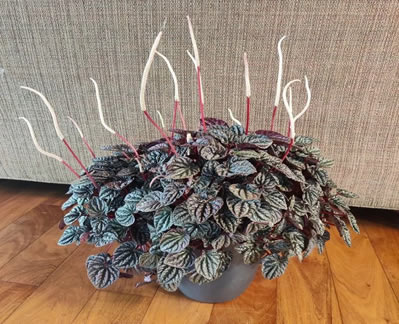
Much more so than being heat-intolerant though, peperomia is cold-intolerant.
This plant can only withstand temperatures down to 50°F. Once it’s colder than that, your plant is likely to succumb to cold shock.
The cold temperatures, even though they might not be that chilly to you, will cause a peperomia to experience foliar discoloration and leaf drooping.
If the temperatures get cold enough, below 50°F, the peperomia’s cells can even freeze. As the cold water floods the cell walls, the walls will rupture. There’s no coming back from that kind of damage.
When determining where to place your peperomia, be sure to keep it away from drafty areas such as a wall air conditioner (even if the unit isn’t on), a radiator or heater, a fridge or freezer, and any old doors or windows that aren’t sealed. The effects from the fluctuating temperatures that accompany such locations will seriously damage your plant and may even kill it.
Peperomia Plant Fertilizer Guide
Almost every houseplant requires fertilizer at least a few times per year, usually during the active growing season. The same is true for peperomia.
Fertilizing is where this plant genus’ care is really easy. Peperomia species require a fertilizer with a balanced mix of the macronutrients nitrogen, potassium, and phosphorus.
When & how to feed your peperomia
So is it necessary to fertilize your peperomia?
Peperomia needs fertilizer during its growing season.
A well balanced fertilizer is best in liquid form though fertilizer spikes also work well.
You can fertilize your plant as frequently as once every two weeks or as seldom as once a month.
When shopping for fertilizer, you should look for a label that reads three of the same numbers on the package, such as 10-10-10 or 20-20-20.
Use a water-soluble fertilizer that will gradually dissolve in the soil. You can add it to the water when you water your peperomia. It’s really just a matter of choice if you want to use liquid fertilizer or powder. You can even use fertilizer spikes.
Apply the fertilizer during the peperomia’s active growing season only. This begins in the spring and lasts until the fall. When growing season finishes you should quit fertilizing the plant until next spring.
As I mentioned above, you can fertilize your plant as frequently as once every two weeks or as seldom as once a month.
I’d recommend starting with monthly feedings and then increasing the amount if your plant isn’t growing as you want. Jumping right into a very frequent fertilizer schedule isn’t always what’s best for a plant. Houseplants can develop fertilizer burn from all the salts in the fertilizer if you feed them the stuff too often.
If you overfertilize peperomia you might notice telltale fertilizer crust along the top surface of the soil. Your peperomia could also begin wilting, browning, or yellowing.
In such a case you will have to flush the soil several times to ensure all the leftover salts are gone ensuring the water drains off well as you don’t want the plant to sit in standing water.
Rather than flushing soil though I prefer to repot the plant in fresh soil.
The Problem With Peperomia Blooms
Not many people realise that peperomias can bloom.
Now, that doesn’t mean too much if you’re hoping for gorgeous, tropical-looking flowers.
Peperomia can bloom though the blooms do not resemble flowers as most people think of them. What a peperomia usually grows is a long stalk, or spike, in brown or green.
There are no petals, and the colors are not very appealing either.
In fact, the peperomia flowers are generally regarded as unattractive to those who grow this plant.
Peperomia is a perennial bloomer
How often can you expect to see those unsightly “flowers” on your peperomia plant?
Indoor peperomias bloom incredibly rarely. Outdoor peperomia are better bloomers.
Should your houseplant grow flowers, it’s a sign that you’re caring for the plant exceptionally well.
Those spikes on your peperomia are actually its blooms
When peperomia blooms it produces spike-like protrusions. Many peperomia owners do not know what these spikes are.
The spikes on peperomia are the flowers of the plant. They are floral scapes that are also often referred to as spindles.
Although they do not look like conventional flowers, as most people think of them, they are in fact the blooms of a peperomia.
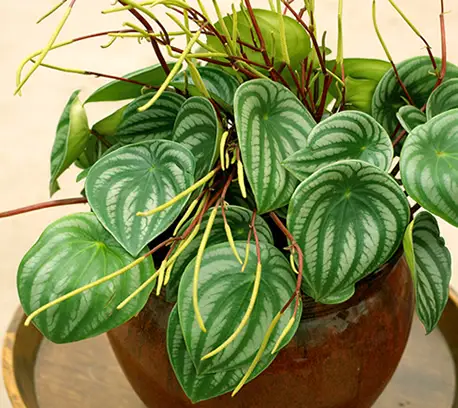
For most people the spikes on a peperomia are unsightly and detract from the look of the plant (I am one such person).
You may be wondering if it is of to prune away these spikes to restore your plant to its original look before it bloomed.
To remove or not remove peperomia flowers, that is the question
Should you cut those unsightly spikes away from your peperomia or will doing so hurt the plant?
You can leave the flowers on a peperomia and allow then to die and fall off over time. However, it is perfectly fine to remove the flowers as, in most cases, they detract from the overall pleasant look of the plant. Removing the flowers will not harm the plant.
Many gardeners will opt to pinch the blooms right off their peperomia as they look unattractive and so that they can more appreciate the glossy, smooth leaves of their peperomia.
Even if the flowers don’t fit your definition of attractive, you should still be proud of yourself for encouraging the peperomia to bloom though. Only very well-cared for peperomia houseplants bloom.
Blooming, if it’s to occur at all, would happen in the spring when the peperomia’s active growing season is underway.
How to get your peperomia to flower (if you really want that)
What if you want to see your peperomia bloom, is there anything you can do to force blooming?
To get a peperomia to bloom you must ensure your care routine is 100% correct. Giving the plant 16 hours of strong indirect light, or artificial light, during growing season will encourage the plant to bloom.
Keep in mind though, that rather than encouraging a peperomia to bloom most peperomia houseplant owners do not want their plant to bloom due to the unattractive nature of the blooms.
How To Make Your Peperomia Grow Bigger & Fuller
Once you begin cultivating peperomia you may become frustrated at the slow growth rate and the lack of plant fullness.
Worry not, there are ways to encourage more plant growth.
How to grow a bigger peperomia
So, what if you want to increase you peperomia’s growth, what can you do?
- To make a peperomia bigger, repot it in a larger container.
- Give the plant a well-balanced fertilizer every 2 – 4 weeks during growing season.
- Ensure the plant gets 12 – 16 hours of strong indirect light per day.
- Water when the top layer of soil dries out.
The most important thing you can do for a peperomia to help encourage new growth is to make sure the plant is getting enough of the correct type of light (see section above).
Also ensure you repot your peperomia in a bigger container when you want it to grow bigger so the roots have room to grow and expand.
How to get a fuller peperomia
Most peperomia plants look quite full unless they are planted in a pot that is too big for them. For those of you who wish to make your peperomia fuller there are 2 methods to do this.
- The first is selective pruning where you remove the top of plant to give the illusion of a thicker plant.
- The second is to plant two or more of the same peperomia species in the same pot side by side.
- You can also propagate new plants in the same pot to create the same result.
I prefer to plant 2 peperomia together in the same pot if I want a very full look.
Although they are separate plants, due to the full foliage the combination of two or more plants gives the impression that there is only one very large plant.
Peperomia Plant Pruning Guide
Every so often you will want to prune your peperomia.
As well as helping to maintain the look of the plant pruning also encourages new growth. Don’t go at it over enthusiastically though as peperomia are slow growers and it can take time to replace all that foliage you cut off.
Whether it’s the stalk-like flowers or other parts of your peperomia that you want to remove, the time will inevitably come when you have to prune your plant. Here’s how it’s done.
Step 1 – Decide what has to go
Maybe your peperomia got a little leggy because it wasn’t growing in bright enough sunlight or perhaps you have a few flowers you want to trim off.
You may also choose to remove dead stems and leaves. Even though those parts are dead, your peperomia still must use energy to support the leaves, so removing them allows the plant to dedicate to wasted resources elsewhere.
Whatever your reason for peperomia pruning … it’s time to pick up those pruning shears.
Step 2 – Pinch or cut the excess
Once you’ve got your pruning targets acquired, find the stem of the part of the plant you want to remove.
Hold it in-between your fingers and pinch or cut. The stem should come right off with just a pinch.
You want to pinch between the first pair of leaves and the end of the stem. Go through all the growths you want to rewove and pinch, or cut, as necessary.
Step 3 – Stop and assess every now and then
As you pinch your peperomia, be sure to stop what you’re doing after a few minutes and assess the state of your plant.
You don’t want to strip the poor peperomia down to nothing as this slow grower will take time to regrow new foliage, so pinch sparingly.

